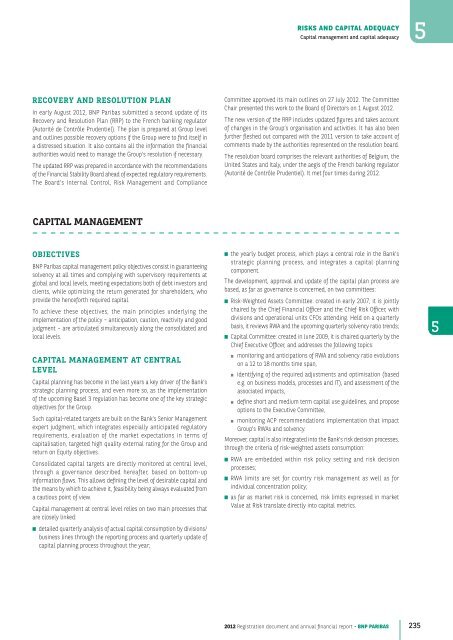2012 Registration document and annual financial report - BNP Paribas
2012 Registration document and annual financial report - BNP Paribas
2012 Registration document and annual financial report - BNP Paribas
- No tags were found...
You also want an ePaper? Increase the reach of your titles
YUMPU automatically turns print PDFs into web optimized ePapers that Google loves.
RISKS AND CAPITAL ADEQUACYCapital management <strong>and</strong> capital adequacy5RECOVERY AND RESOLUTION PLANIn early August <strong>2012</strong>, <strong>BNP</strong> <strong>Paribas</strong> submitted a second update of itsRecovery <strong>and</strong> Resolution Plan (RRP) to the French banking regulator(Autorité de Contrôle Prudentiel). The plan is prepared at Group level<strong>and</strong> outlines possible recovery options if the Group were to find itself ina distressed situation. It also contains all the information the <strong>financial</strong>authorities would need to manage the Group’s resolution if necessary.The updated RRP was prepared in accordance with the recommendationsof the Financial Stability Board ahead of expected regulatory requirements.The Board’s Internal Control, Risk Management <strong>and</strong> ComplianceCommittee approved its main outlines on 27 July <strong>2012</strong>. The CommitteeChair presented this work to the Board of Directors on 1 August <strong>2012</strong>.The new version of the RRP includes updated figures <strong>and</strong> takes accountof changes in the Group’s organisation <strong>and</strong> activities. It has also beenfurther fleshed out compared with the 2011 version to take account ofcomments made by the authorities represented on the resolution board.The resolution board comprises the relevant authorities of Belgium, theUnited States <strong>and</strong> Italy, under the aegis of the French banking regulator(Autorité de Contrôle Prudentiel). It met four times during <strong>2012</strong>.CAPITAL MANAGEMENTOBJECTIVES<strong>BNP</strong> <strong>Paribas</strong> capital management policy objectives consist in guaranteeingsolvency at all times <strong>and</strong> complying with supervisory requirements atglobal <strong>and</strong> local levels, meeting expectations both of debt investors <strong>and</strong>clients, while optimizing the return generated for shareholders, whoprovide the henceforth required capital.To achieve these objectives, the main principles underlying theimplementation of the policy – anticipation, caution, reactivity <strong>and</strong> goodjudgment – are articulated simultaneously along the consolidated <strong>and</strong>local levels.CAPITAL MANAGEMENT AT CENTRALLEVELCapital planning has become in the last years a key driver of the Bank’sstrategic planning process, <strong>and</strong> even more so, as the implementationof the upcoming Basel 3 regulation has become one of the key strategicobjectives for the Group.Such capital- related targets are built on the Bank’s Senior Managementexpert judgment, which integrates especially anticipated regulatoryrequirements, evaluation of the market expectations in terms ofcapitalisation, targeted high quality external rating for the Group <strong>and</strong>return on Equity objectives.Consolidated capital targets are directly monitored at central level,through a governance described hereafter, based on bottom-upinformation flows. This allows defining the level of desirable capital <strong>and</strong>the means by which to achieve it, feasibility being always evaluated froma cautious point of view.Capital management at central level relies on two main processes thatare closely linked:■ detailed quarterly analysis of actual capital consumption by divisions/business lines through the <strong>report</strong>ing process <strong>and</strong> quarterly update ofcapital planning process throughout the year;■ the yearly budget process, which plays a central role in the Bank’sstrategic planning process, <strong>and</strong> integrates a capital planningcomponent.The development, approval <strong>and</strong> update of the capital plan process arebased, as far as governance is concerned, on two committees:■ Risk- Weighted Assets Committee: created in early 2007, it is jointlychaired by the Chief Financial Officer <strong>and</strong> the Chief Risk Officer, withdivisions <strong>and</strong> operational units CFOs attending. Held on a quarterlybasis, it reviews RWA <strong>and</strong> the upcoming quarterly solvency ratio trends;■ Capital Committee: created in June 2009, it is chaired quarterly by theChief Executive Officer, <strong>and</strong> addresses the following topics:■■■monitoring <strong>and</strong> anticipations of RWA <strong>and</strong> solvency ratio evolutionson a 12 to 18 months time span,identifying of the required adjustments <strong>and</strong> optimisation (basede.g. on business models, processes <strong>and</strong> IT), <strong>and</strong> assessment of theassociated impacts,define short <strong>and</strong> medium term capital use guidelines, <strong>and</strong> proposeoptions to the Executive Committee,■ monitoring ACP recommendations implementation that impactGroup’s RWAs <strong>and</strong> solvency.Moreover, capital is also integrated into the Bank’s risk decision processes,through the criteria of risk- weighted assets consumption:■ RWA are embedded within risk policy setting <strong>and</strong> risk decisionprocesses;■ RWA limits are set for country risk management as well as forindividual concentration policy;■ as far as market risk is concerned, risk limits expressed in marketValue at Risk translate directly into capital metrics.5<strong>2012</strong> <strong>Registration</strong> <strong>document</strong> <strong>and</strong> <strong>annual</strong> <strong>financial</strong> <strong>report</strong> - <strong>BNP</strong> PARIBAS 235





